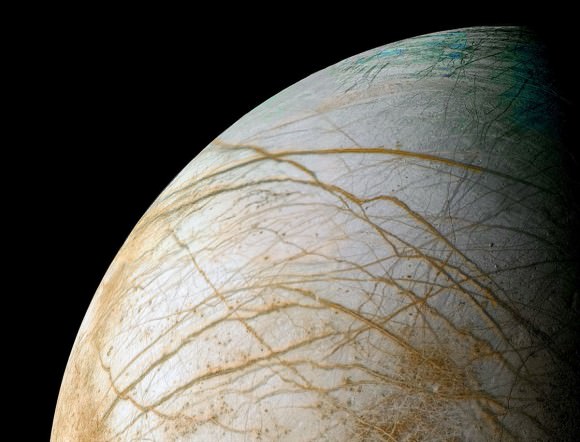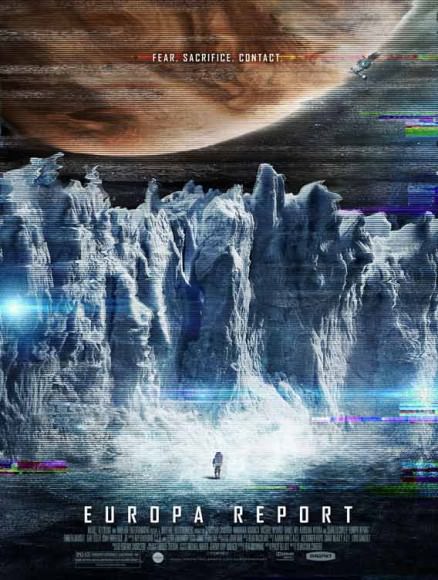The cool thing about space missions is long after they conclude, the data can yield the most interesting information. Here’s an example: Jupiter’s moon Europa may have a ripe spot for organic materials to take root.
Scouring the data from NASA’s past Galileo mission — which ended a decade ago — scientists unveiled an area with “clay-like minerals” on it that came to be after an asteroid or comet smashed into the surface. The connection? These celestial party-crashers often carry organics with them.
“Organic materials, which are important building blocks for life, are often found in comets and primitive asteroids,” stated Jim Shirley, a research scientist at NASA’s Jet Propulsion Laboratory. “Finding the rocky residues of this comet crash on Europa’s surface may open up a new chapter in the story of the search for life on Europa.”

Europa is considered one of the best spots in our solar system to look for life, due to the ocean lurking beneath its icy surface, surface salts that can provide energy, and a source of heat as the mighty Jupiter squeezes and releases the moon like a tennis ball.
The minerals (called phyllosilicates) emerged after Shirley’s team ran a new analysis on infrared pictures snapped by Galileo in 1998, basically working to refine the signal out of the images (which are much lower quality than what we are capable of today).
After the analysis, the phyllosilicates appeared in a “broken ring”, NASA stated, about 75 miles (120 kilometers) away from a crater site. The crater itself is about 20 miles (30 kilometers) in diameter. Scientists are betting that the ring of phyllosilicates is debris (“splash back of material”, NASA says), after a celestial body struck at or around a 45 degree angle from vertical. It’s unlikely the phyllosilicates came from Europa’s ocean given the crust, which can be as thick as 60 miles (100 kilometers).

“If the body was an asteroid, it was likely about 3,600 feet (1,100 meters) in diameter. If the body was a comet, it was likely about 5,600 feet (1,700 meters) in diameter. It would have been nearly the same size as the comet ISON before it passed around the sun a few weeks ago,” NASA stated.
To be clear, nobody has found organic materials on Europa directly, and even if they were detected it would then be another feat of science to determine if they related to life or not. This does, however, lend credence to theories that life came to Earth through comets and asteroids.
Ample fodder to consider as the community waits for the European Space Agency’s JUICE (JUpiter ICy moons Explorer) to get going to Europa and Jupiter upon its expected launch in 2022. The probe should arrive there in 2030.
Shirley will give a talk on this topic at the American Geophysical Union’s fall meeting on Friday.
Source: NASA


Elizabeth Howell claims that asteroids and/or comets “… often carry organics with them.” . May I ask – WHAT IN THE UNIVERSE YOU ARE BASING THIS? Of all the celestial debris that has been studied, only ONE object (Meteorite ALH84001) has even been thought, by a few, to have carried organics with them. So please, lets be scientific, and let not your imagination try to illude your readers! Perhaps you should write fiction?
Here’s a great explanation of tidal forces. Jupiter alone doesn’t do it, the neighbouring moons do the trick:
http://www.astro.washington.edu/users/smith/Astro150/Tutorials/TidalHeat/
The Voyager probes passed by Jupiter at the same speed, relative to the Sun, as that of Europa itself (it just happens to orbit Jupiter at the same speed as Jupiter orbits the Sun). Doesn’t the high orbital speed of the large Jovian moons make them quite easy to land on? Hardly any landing system would be needed, the probe just needs to grab a hold on to the moon as it for a moment tangents the probe’s trajectory with zero speed difference.
Orbiting Europa is quite difficult because of the varying gravity landscape of the system, but landing on it should be much easier than landing on Mars. Icy moons could be very common objects in the universe and should be top priority for exploration.
Sixteen more years to get a probe there. What a sad commentary on our nearly-complete abandonment of exploration.
You’re confusing the controversial claims of fossilized organisms with basic organic chemicals, a common mistake of thinking of “lifeforms” whenever someone mentions “organics”… the article is spot on.
This adds another reason, to the other grammatical and unnecessarily
brutal ones, that immediately after I had impulsively pushed the send-button, I
regretted it!
My appreciation to you, Dave, for your kind attention.
For good reason there is a common misunderstanding with the word “organics”, being – the most common definition of “organic” is – something produced by living organisms. (like the cow manure I use in my garden).
Ok, in the dictionary, way down the list of definitions, I found Ms Howell’s meaning – referring to chemical compounds.
The confusion should be eliminated by the use of the term “organic compounds”, instead of the ambiguous “organics”.
how come does it take that long for a satlittle to get there time speeds up in space so the sattlite so prob be there
but it takes longer on earth